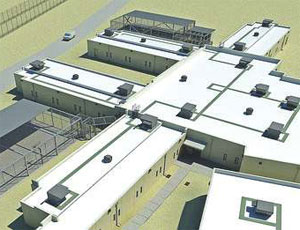Completed this past summer, the Salinas Valley State Prison’s additional 64-bed mental health facility has become the first California Department of Corrections and Rehabilitation project to be certified LEED silver.

The single-story, 36,783-sq-ft mental health facility includes a 31,166-sq-ft housing treatment facility and 5,617-sq-ft administration addition.
The treatment building is arranged in four wings of 16 cells each. The administration building expansion provides additional administrative offices, record storage, a pharmacy and training rooms.
The existing administration building has also been remodeled to accommodate additional clinical staff.
The project required careful planning. After the original $21.1-million budget was approved, California’s governor issued an executive order requiring that the design, construction and operation of new and renovated state-owned facilities paid for with state funds achieve LEED silver criteria.
“We are very proud to have met the challenge of successfully leading the design of CDCR’s first LEED facility. We set the standard for this and future CDCR projects by reducing water usage by half and energy usage by a third,” says George Dyckes, Kitchell deputy program manager.
Kitchell, which provided program management, design review, value engineering and cost-estimating services, proceeded with these LEED certification requirements.
Qualifying for LEED certification is more straightforward for an office building than for a prison facility, according to Kitchell. In a secure setting, adding a window or skylight to achieve LEED credits for daylight and views becomes an expensive proposition. It requires security glazing and secure grills, which can cost 20 times more than standard glazing. And while landscaping is an easy, inexpensive way to contribute to LEED credits on an office building, prisons don’t include any landscaping because it creates hiding places for inmates and contraband.
CDCR relied on Kitchell to help identify which LEED strategies to implement. Kitchell and Nacht & Lewis Architects collaborated to hire Green Building Services, an experienced sustainable design consultant. Because the level of LEED certification is based on accumulated credits, Kitchell says it reviewed sustainable design features that could be achieved based on feasibility and cost.
“We developed a spreadsheet to track the cost of each LEED credit that we considered pursuing,” Dyckes says. This atypical step allowed Kitchell to document the incremental cost of LEED certification to budget for future projects.

Post a comment to this article
Report Abusive Comment